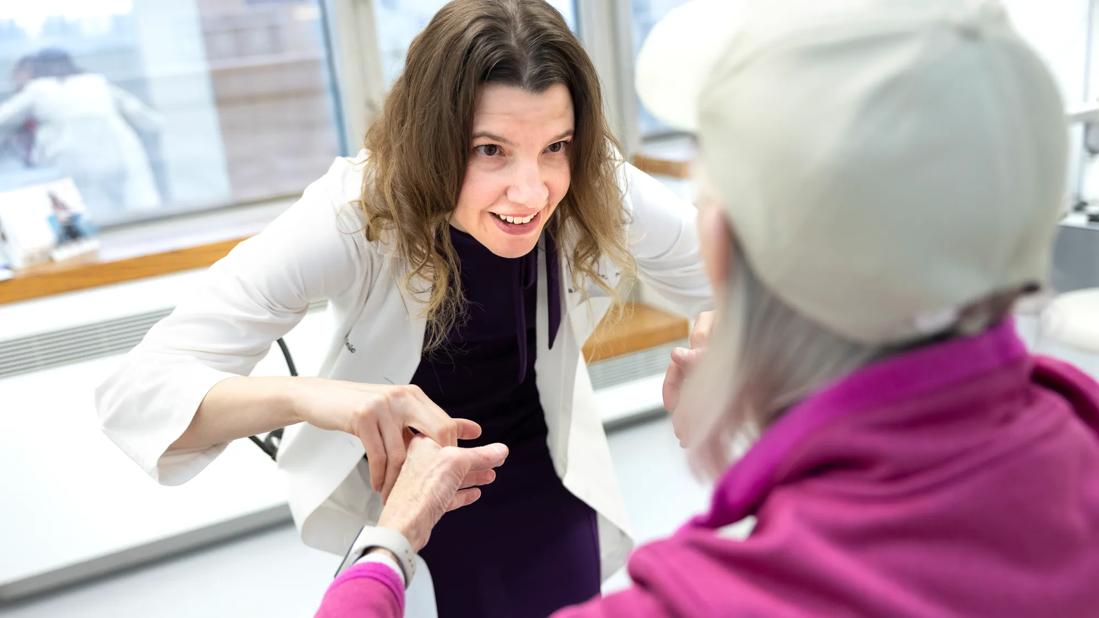Center for Geriatric Medicine leads inpatient care of fragility fractures

Fragility fractures beget more fractures. People who have had a fracture due to osteoporosis are twice as likely as their peers to have another, according to the World Health Organization.
Advertisement
Cleveland Clinic is a non-profit academic medical center. Advertising on our site helps support our mission. We do not endorse non-Cleveland Clinic products or services. Policy
Cleveland Clinic is taking steps to prevent subsequent fractures with a new Fracture Liaison Service, a program to connect patients age 65 and older with all care services needed for recovery — not just from the fracture, but also from its underlying causes.
“Fracture is often a sentinel event related to low bone mass caused by underlying osteopenia and osteoporosis,” says Cleveland Clinic endocrinologist Leila Khan, MD. “One in five men and one in two women over age 50 will break a bone due to osteoporosis.”
Dr. Khan and Cleveland Clinic hospitalist Maria Miklowski, MD, proposed a Fracture Liaison Service at Cleveland Clinic after being introduced to the model in grand rounds with Marcy Bolster, MD, a rheumatologist at Massachusetts General Hospital. The model has been championed by the American Orthopaedic Association’s Own the Bone® program, as well as at Kaiser Permanente Southern California, where it has led to a 40% reduction in hip fractures, and Geisinger Health System in Pennsylvania, where it has reduced costs by $7.8 million over five years.
“Dr. Bolster’s impactful work in caring for patients with fragility fractures inspired us to create something comparable at Cleveland Clinic,” says Dr. Miklowski. “Dr. Khan and I then reached out to stakeholders at main campus and created a multidisciplinary team.”
Their grassroots effort won support from leaders in endocrinology, rheumatology and orthopaedics. But it was support from the Center for Geriatric Medicine that had a profound effect in establishing the program with a distinct Cleveland Clinic flair.
Advertisement
“Having a specialized geriatric team and specialized follow-up assessment has been shown to reduce in-hospital and one-year mortality rates,” says Dr. Miklowski. “Dr. Khan and I are grateful to the Center for Geriatric Medicine for making this service possible and anticipate success with their taking the lead on inpatient consults.”
Literature shows the value of multidisciplinary care, including geriatric care, for patients with osteoporosis, notes Dr. Khan.
Before the Fracture Liaison Service, patients hospitalized with fragility fractures at Cleveland Clinic would be treated by an orthopaedic specialist and then often discharged to rehabilitation before returning home.
In a chart review of 100 Cleveland Clinic patients (average age 71.8) hospitalized for fragility fracture of the hip, vertebra, leg or pelvis between 2015 and 2018, 53 were readmitted within one year, 26 with a second fracture.
“While 73% of these patients had not been treated for osteoporosis before their first fracture, 72% still were not treated for osteoporosis within two years after the fracture,” says Dr. Miklowski. “In fact, 73% didn’t even have a bone density scan after the fracture.”
The Fracture Liaison Service will ensure excellent osteoporosis and other follow-up care for these patients in addition to their excellent orthopaedic care, she says.
Patients with low-impact fragility fractures — most often hip fractures — first see an orthopaedic specialist. If the patient is admitted to the hospital for surgery or other fracture care, the Fracture Liaison Service is initiated thanks to an orthopaedics electronic order set, which triggers a visit from a geriatric specialist as well as a hospitalist.
Advertisement
“The geriatrician serves as the quarterback, helping guide the patient’s hospital care,” says Ardeshir Hashmi, MD, Section Chief of Cleveland Clinic’s Center for Geriatric Medicine. “With each fracture, a patient can become weaker and more frail. Geriatricians and hospitalists work together to prevent complications that contribute to frailty. We also order blood tests and then refer patients to endocrinology, rheumatology or other specialties for long-term care of osteoporosis.”
Part of the geriatrician’s care involves assessing patients for the Age-Friendly Health Systems “4Ms”:
“Our aim is to reduce the risk of future fractures, reduce mortality, improve the rate of bone density scans and improve the rate of treatment for osteoporosis,” says Dr. Hashmi.
More than 2 million fractures occur in the U.S. each year. By 2025, that number is projected to approach 3 million, accounting for an aging Baby Boomer population.
“Osteoporosis is a natural part of aging,” says Dr. Khan, “but we do have effective treatments developed over the past 20-30 years, so fractures aren’t inevitable.”
Advertisement
The Fracture Liaison Service at Cleveland Clinic soon will be adding a nurse navigator to help patients make appointments and coordinate care. An existing orthopaedics dashboard will help track quality outcomes.
“Of course, as a hospital system, we want to see quality metrics improve, by decreasing costs and reducing readmissions, for example,” says Dr. Hashmi. “Our Fracture Liaison Service supports that goal, not only by healing fractures and treating osteoporosis, but also by improving frailty and reducing fall risk, ensuring patients are stronger and more robust overall.”
Advertisement
Advertisement

Multidisciplinary approach helps address clinical and psychosocial challenges in geriatric care

Effective screening, advanced treatments can help preserve quality of life

Study suggests inconsistencies in the emergency department evaluation of geriatric patients

Auditory hallucinations lead to unusual diagnosis

How providers can help prevent and address this under-reported form of abuse

How providers can help older adults protect their assets and personal agency

Recognizing the subtle but destructive signs of psychological abuse in geriatric patients

Early screening — and shorter boarding times — benefit older adults